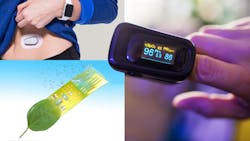Biosensors and Harvesters Go Micro—and Even Nano (Download)
In recent decades, we’ve seen a dramatic increase in the availability and adoption of personal medical devices for measurement and monitoring of critical body parameters. This has been made possible by a combination of ever-tinier and lower-power components, advanced algorithms, and sophisticated sensors.
Clear testimony of this is the optically based fingertip clip-on device that accurately and quickly measures blood-oxygen saturation (SpO2) in real-time (Fig. 1). This ubiquitous $25 unit has obviously obsoleted the invasive, costly, and time-consuming method of drawing a blood sample and sending it to the lab for assessment, and made DIY assessment quick, safe, and easy.
